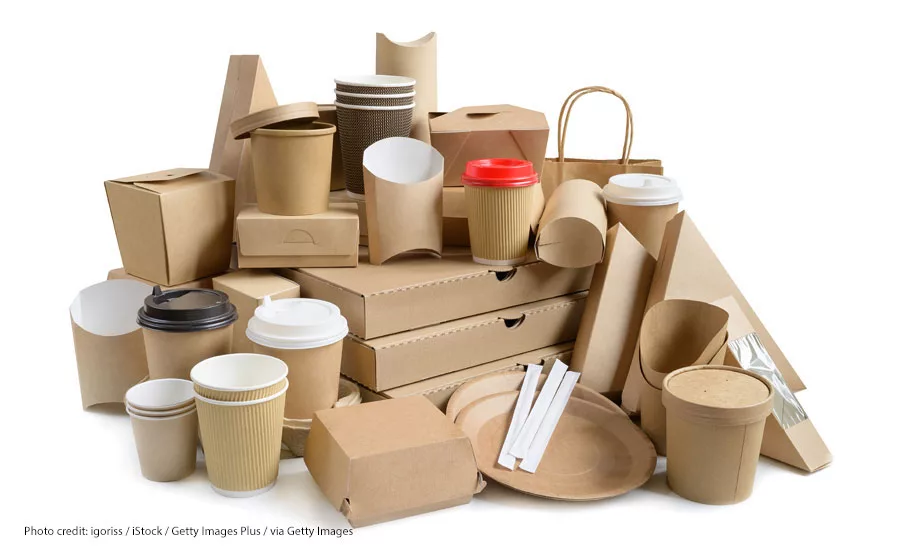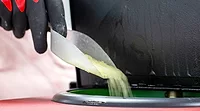These Six Sustainable Adhesive Types Play a Big Role in Sustainable Packaging

As consumers become increasingly eco-conscious, companies face growing pressure to adopt sustainable practices. They’re finding alternatives to traditional products that are harmful to the environment, with adhesives being a great example. Fortunately, there are a variety of sustainable adhesives available that offer effective bonding solutions while minimizing the environmental impact. Here are six types of sustainable adhesives every technical formulator or manufacturer should know about.
1. Water-Based Adhesives
Developed using a mixture of polymers, water and additives, water-based adhesives are a popular choice for sustainable bonding applications. Since water is the primary ingredient used to create the bond, they release fewer harmful VOCs into the atmosphere. This makes them an excellent choice for indoor applications, such as carpet and flooring installations, where VOC emissions can negatively impact indoor air quality.
Water-based adhesives are also non-flammable and non-toxic, making them a safer alternative to solvent-based adhesives. Ideally, they work with porous and non-porous substrates — the former being materials like glass, metal, plastic, and finished wood, and the latter being untreated wood, fabrics, carpet, and cardboard.
2. Plant-Based Adhesives
Plant-based sustainable adhesives are made from renewable materials such as starch, cellulose and vegetable oil. These biodegradable and compostable materials are an ideal choice for applications where sustainability is a priority. Plant-based adhesives can be used in a variety of industries, including packaging, woodworking and textiles. They are also a safe choice for applications where the adhesive will come into contact with food, as they’re non-toxic and do not contain harmful chemicals.
Sometimes referred to as natural glue, certain forms may contain both natural and manufactured materials such as starch, tar, gum arabic, natural latex rubber and waterglass. It should also be noted that plant-based sustainable adhesives are considered to be separate from standard biodegradeables due to their general makeup.
3. Biodegradable Adhesives
Biodegradable adhesives are designed to break down naturally over time, reducing their environmental impact. These adhesives are typically made from materials like vegetable starch, which decomposes quickly in soil or water. Biodegradable adhesives are an ideal choice for disposable products such as paper bags and recyclable packaging materials. They are also a good choice for applications where the adhesive needs to be removed easily, as they can be dissolved in water.
There are subsets of biodegradable adhesives worth covering, including:
- Repulpable adhesives: Repulpable adhesives are also biodegradable as they’re fully soluble in water and will not leave behind films or residues.
- Compostable adhesives: Compostable adhesives are biodegradable and can be broken down in a compost pile, similar to plants. They are also compatible with waste remediation systems and won’t cause harm to the surrounding soil, flora, or fauna.
As air, soil and water pollution are all major concerns right now and in the future, an increase in biodegradable solutions will help reduce many of those problems and prevent further pollution to our environment. Adhesives play a big role in eliminating pollution, as they’re used in a wide variety of products, goods, equipment and beyond — most of which ends up in landfills and refuse piles.
4. Recyclable Adhesives
Another form of sustainable adhesive, recyclables are designed to be easily separated from the materials they bond with, while still being fully compatible with a wide range of substrates, making them an ideal choice for applications where smooth and simple cleanup is a priority. When a product or material has reached the end of its life, the adhesives can be melted down for reuse or disposal, without leaving any residues.
These adhesives are typically made from materials that can be recycled multiple times without losing quality. Recyclable adhesives are commonly used for automotive applications or to adhere to glass, aluminum, steel and certain alloys. There has been advancement in this particular area, with sustainable options being tested.
5. UV-Cured Adhesives
UV-cured adhesives or sealants use the sun’s natural ultraviolet light to activate the bonding process, eliminating the need for solvents or other harmful chemicals. Since they do not contain VOCs, they’re considered to be much less harmful and a viable eco-friendly alternative.
While not all of them utilize UV-curing, liquid silicone adhesives are a good example of this type of bonding solution. They often contain a two-part system, the first of which cures through air moisture or heat from UV or EB radiation.
These adhesives are commonly used in the electronics and automotive industries, where they help secure small components and parts. UV-cured adhesives offer fast bonding times and can be used on a variety of materials, including glass, metal and plastic. They may also be used in electrical, construction and life sciences.
6. Solvent-Free Adhesives
Solvent-free adhesives are considered to be a more sustainable alternative to traditional solvent-based adhesives, which release harmful VOCs into the atmosphere. Solvent-free adhesives are typically made from materials such as acrylic or epoxy, which require fewer solvents to activate the bonding process. While they may still contain harmful solvents depending on the materials used, there are always less than 5% of harmful inclusions — anything more is classified as solvent-based.
These adhesives are also non-flammable and non-toxic, making them an excellent choice for indoor applications where air quality is a concern. They’re famously easy to work with, even in small spaces, which is convenient for construction, commercial and industrial applications too.
Additional Sustainability Considerations
In addition to the adhesives themselves, sustainable solutions can also involve changes in application techniques and equipment. For example, switching to automated adhesive dispensing systems can help minimize waste and ensure accurate adhesive application while also reducing the amount of labor required.
The Benefits of Sustainable Adhesives
Overall, sustainable adhesives offer a range of benefits that traditional adhesive products do not. These adhesives minimize environmental impact, reduce waste and improve indoor air quality to help companies meet their sustainability goals while still achieving strong, durable bonding solutions.
Companies that adopt these products may also see financial benefits. Many sustainable adhesive solutions offer reduced waste, lower material costs and increased efficiency, which contribute to cost savings over time.
It's important to note that while sustainable adhesives are an excellent alternative to traditional adhesive products, they may not be suitable for every application. Companies should carefully evaluate their bonding needs and consider factors such as strength, durability and environmental impact when choosing an alternative.
Prioritizing Sustainability in Manufacturing and Beyond
As the demand for environmentally-conscious products continues to grow, we will likely see an increasing number of sustainable adhesive solutions on the market. Companies that prioritize sustainability in their operations will be well-positioned to meet consumer demand and differentiate themselves from competitors. Outlying benefits include cost savings and higher customer satisfaction ratings — people are on board with green initiatives.
Indeed, sustainable adhesives offer a range of benefits over traditional adhesive products, including reduced environmental impact, improved indoor air quality and cost savings. By carefully evaluating their bonding needs and considering the strengths and weaknesses of various adhesive solutions, companies can make informed decisions about which sustainable adhesive products are right for their operations.
Emily Newton is the editor-in-chief of Revolutionized Magazine. She has over four years experience covering industrial trends for the manufacturing industry.
Looking for a reprint of this article?
From high-res PDFs to custom plaques, order your copy today!





